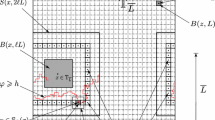Abstract
We consider level-set percolation for the Gaussian free field on \({\mathbb{Z}^{d}}\), d ≥ 3, and prove that, as h varies, there is a non-trivial percolation phase transition of the excursion set above level h for all dimensions d ≥ 3. So far, it was known that the corresponding critical level h *(d) satisfies h *(d) ≥ 0 for all d ≥ 3 and that h *(3) is finite, see Bricmont et al. (J Stat Phys 48(5/6):1249–1268, 1987). We prove here that h *(d) is finite for all d ≥ 3. In fact, we introduce a second critical parameter h ** ≥ h *, show that h **(d) is finite for all d ≥ 3, and that the connectivity function of the excursion set above level h has stretched exponential decay for all h > h **. Finally, we prove that h * is strictly positive in high dimension. It remains open whether h * and h ** actually coincide and whether h * > 0 for all d ≥ 3.
Similar content being viewed by others
References
Adler R.J., Taylor J.E.: Random fields and geometry. Springer, New York (2007)
Bricmont J., Lebowitz J.L., Maes C.: Percolation in strongly correlated systems: the massless Gaussian field. J. Stat. Phys. 48(5/6), 1249–1268 (1987)
Cramér H., Leadbetter M.R.: Stationary and related stochastic processes. Wiley, New York (1967)
Campanino M., Russo L.: An upper bound on the critical percolation probability for the three-dimensional cubic lattice. Ann. Prob. 13(2), 478–491 (1985)
Garet, O.: Percolation transition for some excursion sets. Elec. J. Prob. 9, paper no. 10, 255–292 (2004)
Georgii, H.-O., Häggström, O., Maes, C.: The random geometry of equilibrium phases. Phase Transitions and Critical Phenomena, edited by C. Domb and J. Lebowitz, 14, London-New York: Academic Press, 2001, pp. 1–142
Gandolfi A., Keane M., Russo L.: On the uniqueness of the infinite occupied cluster in dependent two-dimensional site percolation. Ann. Prob. 16(3), 1147–1157 (1988)
Grimmett, G.R.: Percolation. Berlin: Springer, 2nd ed., 1999
Grimmett G.R., Marstrand J.M.: The supercritical phase of percolation is well-behaved. Proc. Roy. Soc. (London), Series A 430, 439–457 (1990)
Häggström O., Jonasson J.: Uniqueness and non-uniqueness in percolation theory. Probab. Surv. 3, 289–344 (2006)
Lawler G.F.: Intersections of random walks. Birkhäuser, Basel (1991)
Lebowitz J.L., Saleur H.: Percolation in strongly correlated systems. Phys. A 138, 194–205 (1986)
Liggett T.M.: Interacting Particle Systems. Springer, New York (1985)
Liggett T.M., Schonmann R.H., Stacey A.M.: Domination by product measures. Ann. Prob. 25(1), 71–95 (1997)
Marinov, V.: Percolation in correlated systems. PhD Thesis, Rutgers University. Available online at: http://www.books.google.com/books?isbn=0549701338, 2007
Montroll E.W.: Random walks in multidimensional spaces, especially on periodic lattices. J. Soc. Indus. Appl. Math. 4(4), 241–260 (1956)
Molchanov S.A., Stepanov A.K.: Percolation in random fields I. Teoret. Mat. Fiz. 55(2), 246–256 (1983)
Pisztora A.: Surface order large deviations for Ising, Potts, and percolation models. Prob. Th. Rel. Fields 104, 427–466 (1996)
Ráth, B., Sapozhnikov, A.: The effect of small quenched noise on connectivity properties of random interlacements. Available at http://arxiv.org/abs/1109.5086v2 [math.PR], 2012
Reed M., Simon B.: Methods of modern mathematical physics, Vol. II: Fourier-analysis, self-adjointness. Academic Press, New York (1975)
Sidoravicius V., Sznitman A.S.: Connectivity bounds for the vacant set of random interlacements. Ann. Inst. H. Poincaré, Prob. Stat. 46(4), 976–990 (2010)
Spitzer, F.: Principles of Random Walk. New York: Springer, 2nd ed., 1976
Sznitman A.S.: Vacant set of random interlacements and percolation. Ann. Math. 171, 2039–2087 (2010)
Sznitman A.S.: Decoupling inequalities and interlacement percolation on \({G \times \mathbb{Z}}\). Invent. Math. 187, 645–706 (2012)
Sznitman A.S.: An isomorphism theorem for random interlacements. Electron. Commun. Prob. 17(9), 1–9 (2012)
Sznitman, A.S.: Topics in occupation times and Gaussian free fields. Zurich Lecture Notes in Advanced Mathematics, Zürich: EMS, 2012
Teixeira A.: On the size of a finite vacant cluster of random interlacements with small intensity. Prob. Th. Rel. Fields 150(3-4), 529–574 (2011)
Author information
Authors and Affiliations
Corresponding author
Additional information
Communicated by M. Aizenman
This research was supported in part by the grant ERC-2009-AdG 245728-RWPERCRI.
Rights and permissions
About this article
Cite this article
Rodriguez, PF., Sznitman, AS. Phase Transition and Level-Set Percolation for the Gaussian Free Field. Commun. Math. Phys. 320, 571–601 (2013). https://doi.org/10.1007/s00220-012-1649-y
Received:
Accepted:
Published:
Issue Date:
DOI: https://doi.org/10.1007/s00220-012-1649-y



